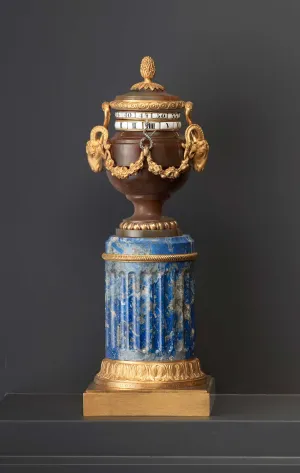Early Work
Vase and Two Incense Burners, 1764
Gilt bronze by Pierre Gouthière (1732–1813)
Faux porphyry carved by Jean-François Hermand
Stucco imitating porphyry and gilt bronze
Royal Castle, Warsaw
This set was purchased in 1764 in the Parisian workshop of the sculptor and silversmith François-Thomas Germain. The purchase was made on behalf of Stanislas-August Poniatowski, an art connoisseur and the future king of Poland (r. 1764–95). Gouthière claimed authorship in an undated letter he and the silversmith Jean Rameau boldly wrote to the Polish sovereign to circumvent Germain:
Small Clock with Horizontal Rotating Face, 1767
Gilt bronze by Pierre Gouthière (1732–1813)
Painted wood, gilt bronze, and enamel
Musée Cognacq-Jay, Paris
Inscription on the collar: fait par gouthiere ciseleur doreur / du roy quay pelletier 1767
(Made by Gouthière Chaser Gilder / to the King Quay Pelletier 1767)
See the other Small Clock with Horizontal Rotating Face
Early in his career, Gouthière created a number of models that could be customized for various clients, as this clock and the other small clock have been. The example here is made of wood originally painted in imitation of lapis lazuli but now covered by a thick layer of dark blue paint, while the other clock is made of semi-precious stones, using lapis lazuli for the column and agate for the covered vase.
Pair of Ewers, 1767
Pierre Gouthière (1732–1813)
Gilt bronze
Frick Art and Historical Center, Pittsburgh
Inscription on the base: fait par gouthiere ciseleur doreur / du roy quay pelletier 1767
(Made by Gouthiere Chaser Gilder / to the King Quay Pelletier 1767)
Gouthière had been a master chaser-gilder for nearly ten years when, on November 7, 1767, he received the title of gilder to the king “on the basis of testimony we possess as to the intelligence, ability and integrity of Mr. Gouthière, merchant gilder in Paris.” Over the next two months, he completed these two ewers, engraving his new title on the rectangular base of the mermaid-handled ewer. Bronze-makers rarely signed their works, but it was standard practice for goldsmiths and silversmiths to do so.
Pair of Ewers, ca. 1767–70
Gilt bronze by Pierre Gouthière (1732–1813)
Porphyry and gilt bronze
Private collection
The mounts on these two ewers bear many features that recur in Gouthière’s work, among them, the naturalistic chasing of the veins of the leaves, the highly expressive human and animal figures, and the extremely fine stippling used for the textures of the bodies and faces. Also noteworthy is the matte gilding, a specialty of Gouthière’s, on everything but details such as the dolphins’ eyes, the ribbon bows, and the draperies, which are burnished.
Small Clock with Horizontal Rotating Face, 1767
Gilt bronze by Pierre Gouthière (1732–1813)
Lapis lazuli, agate, gilt bronze, and enamel
Private collection
Inscription on the collar: fait par gouthiere ciseleur doreur / du roy quay pelletier 1767
(Made by Gouthière Chaser Gilder / to the King Quay Pelletier 1767)
See the other Small Clock with Horizontal Rotating Face
Early in his career, Gouthière created a number of models that could be customized for various clients, as this clock and the other small clock have been. The example here is made of semi-precious stones, using lapis lazuli for the column and agate for the covered vase, while the other clock is made of wood originally painted in imitation of lapis lazuli but now covered by a thick layer of dark blue paint.





